cherokee indians
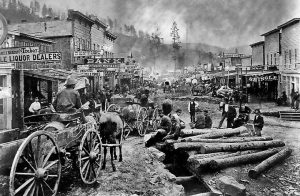 Anyone who has spent much time in the Black Hills has most likely seen Deadwood, and knows it to be a historic gambling town where many famous Wild West characters hung out and died. Legends like Wild Bill Hickok and Calamity Jane each left their mark. Hickok, a legendary man even in his own lifetime, was shot in the back of the head by Jack McCall, while playing poker at the No. 10 Saloon on August 2, 1876. Calamity Jane was renowned for her excellent marksmanship, as well as her preference for men’s clothing, and brash behavior.
Anyone who has spent much time in the Black Hills has most likely seen Deadwood, and knows it to be a historic gambling town where many famous Wild West characters hung out and died. Legends like Wild Bill Hickok and Calamity Jane each left their mark. Hickok, a legendary man even in his own lifetime, was shot in the back of the head by Jack McCall, while playing poker at the No. 10 Saloon on August 2, 1876. Calamity Jane was renowned for her excellent marksmanship, as well as her preference for men’s clothing, and brash behavior.
Deadwood also had, in addition to its tough individuals, others such as Reverend Henry W. Smith. Preacher Smith was the first Methodist minister to come to the Black Hills. Smith was mysteriously murdered on Sunday, August 20, 1876, while walking to Crook City to deliver a sermon. These individuals are just a few of the many notables buried in Mount Moriah Cemetary, which was established in 1877 or 1878.
That’s all well known to many people, but some may not know that the settlement of Deadwood began illegally in the 1870s on land which had been granted to the Native Americans. In 1874, Colonel George Armstrong Custer led an expedition into the Black Hills and announced the discovery of gold on French Creek near what is now Custer, South Dakota. That announcement ushered in the Black Hills Gold Rush and gave rise to the new and lawless town of Deadwood. In 1875, a miner named John Pearson found gold in a narrow canyon in the Northern Black Hills. This canyon became known as “Deadwood Gulch,” because of the many dead trees that lined the canyon walls at that time. The name stuck. Try as they might, the government couldn’t keep the situation under wraps, in order to honor the 1868 Treaty of Fort Laramie, which forever ceded the Black Hills to the Lakota-Sioux. The government dispatched several military units to forts in the surrounding area to keep people from entering the Hills. However, people illegally entered the area anyway, searching for gold or adventure. Despite the efforts of the military and federal government. They were driven by dreams and greed.
Once Deadwood was established, the mining camp was quickly swarming with thousands of prospectors searching for an easy way to get rich. Fred and Moses Manuel, claimed the Homestake Mine, which proved to be the most profitable in the area. Although the Manuels had been lucky, others were not so fortunate. Most of the early population was in Deadwood to mine for gold, but the lawless town naturally attracted a crowd of rough and shady characters too. These particular individuals made the early days of Deadwood rough and wild. 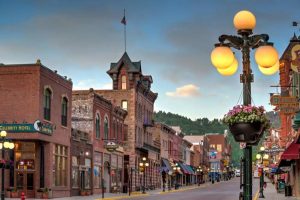 A mostly male population eagerly patronized the many saloons, gambling establishments, dance halls, and brothels. These establishments were considered legitimate businesses and were well known throughout the area.
A mostly male population eagerly patronized the many saloons, gambling establishments, dance halls, and brothels. These establishments were considered legitimate businesses and were well known throughout the area.
In 1890, the railroad connected the town to the outside world. Illegal beginnings aside, Deadwood was a town that was now here to stay. The treaty with the Lakota-Sioux was broken and the Black Hills would never again belong to them. As unfair as it was to break the treaty, I don’t think that it could have lasted forever anyway, because the United Stated was going to be populated from coast to coast one way or the other.
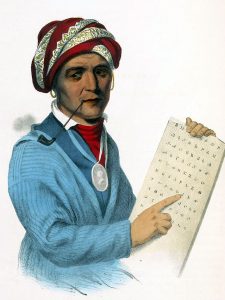 The Indian tribes in the United States had a spoken language, but in the early years they had no real need for a written language, other than hieroglyphics. At some point, a young Cherokee man named Sequoyah noticed something about the men in Andrew Jackson’s platoon, while he and some other Cherokee men were volunteering in the fight against the British in the War of 1812. In dealing with the Anglo soldiers and settlers, Sequoyah became intrigued by their “talking leaves” or printed books. Sequoyah realized that somehow the “talking leaves” recorded human speech. In a brilliant leap of logic, Sequoyah comprehended the basic nature of symbolic representation of sounds and in 1809 he began working on a similar system for the Cherokee language. Little did Sequoyah know that his work would change things, and in fact, change life for the Cherokee people. Still, it was not without it’s downside. Sequoyah was ridiculed and misunderstood by most of the Cherokee. Nevertheless, he made slow progress until he came up with the idea of representing each syllable in the language with a separate written character. Finally, he perfected his syllabary of 86 characters, a system that could be mastered in less than week. After obtaining the official endorsement of the Cherokee leadership, Sequoyah’s invention was soon adopted throughout the Cherokee nation.
The Indian tribes in the United States had a spoken language, but in the early years they had no real need for a written language, other than hieroglyphics. At some point, a young Cherokee man named Sequoyah noticed something about the men in Andrew Jackson’s platoon, while he and some other Cherokee men were volunteering in the fight against the British in the War of 1812. In dealing with the Anglo soldiers and settlers, Sequoyah became intrigued by their “talking leaves” or printed books. Sequoyah realized that somehow the “talking leaves” recorded human speech. In a brilliant leap of logic, Sequoyah comprehended the basic nature of symbolic representation of sounds and in 1809 he began working on a similar system for the Cherokee language. Little did Sequoyah know that his work would change things, and in fact, change life for the Cherokee people. Still, it was not without it’s downside. Sequoyah was ridiculed and misunderstood by most of the Cherokee. Nevertheless, he made slow progress until he came up with the idea of representing each syllable in the language with a separate written character. Finally, he perfected his syllabary of 86 characters, a system that could be mastered in less than week. After obtaining the official endorsement of the Cherokee leadership, Sequoyah’s invention was soon adopted throughout the Cherokee nation.
Finally, it was time for the next step. The General Council of the Cherokee Nation decided to purchase a 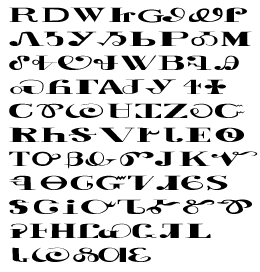 printing press. Their goal was to produce a newspaper in the Cherokee language. When the Cherokee-language printing press arrived on this day, February 21, 1828, the lead type was based on Sequoyah’s syllabary. Within months, the first Indian language newspaper in history appeared in New Echota, Georgia. It was called the Cherokee Phoenix. The Cherokee tribe was one of what the Americans called the “five civilized tribes” and they were native to the American Southeast. The Cherokee had long ago decided to embrace the United States’ program of “civilizing” Indians in the years after the Revolutionary War. In the minds of Americans, Sequoyah’s syllabary showed the Cherokee desire to fit into their dominant Anglo world. The Cherokee used their new press to print a bilingual version of the republican constitution. They also took many other steps to assimilate Anglo culture and practice while still preserving some aspects of their traditional language and beliefs. The press worked well, but would have been useless had it not been for the extraordinary work of Sequoyah.
printing press. Their goal was to produce a newspaper in the Cherokee language. When the Cherokee-language printing press arrived on this day, February 21, 1828, the lead type was based on Sequoyah’s syllabary. Within months, the first Indian language newspaper in history appeared in New Echota, Georgia. It was called the Cherokee Phoenix. The Cherokee tribe was one of what the Americans called the “five civilized tribes” and they were native to the American Southeast. The Cherokee had long ago decided to embrace the United States’ program of “civilizing” Indians in the years after the Revolutionary War. In the minds of Americans, Sequoyah’s syllabary showed the Cherokee desire to fit into their dominant Anglo world. The Cherokee used their new press to print a bilingual version of the republican constitution. They also took many other steps to assimilate Anglo culture and practice while still preserving some aspects of their traditional language and beliefs. The press worked well, but would have been useless had it not been for the extraordinary work of Sequoyah.
Sequoyah was born about 1770 in Tuskegee, Cherokee Nation, near present day Knoxville, Tennessee. He died 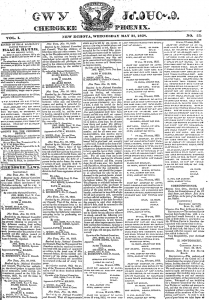 August 1843 at about 72 or 73, in San Fernando, Tamaulipas, Mexico. His name in English is George Gist or George Guess, which I find to be…well, crazy. Why was it necessary to butcher his name. Sequoyah was a Cherokee silversmith by trade, but his biggest claim to fame was the creation of written Cherokee. In 1821, when he completed his independent creation of a Cherokee syllabary, he successfully made reading and writing in Cherokee possible. This was one of the very few times in recorded history that a member of a pre-literate people created an original, effective writing system. After seeing its worth, the people of the Cherokee Nation rapidly began to use his syllabary and officially adopted it in 1825. Their literacy rate quickly surpassed that of surrounding European-American settlers. In recognition of his service, the Cherokee Nation voted Sequoyah an annual allowance in 1841. He died two years later on a trip to San Fernando, seeking Cherokee to return to Oklahoma with him. The giant California redwood tree, Sequoia, was named after him.
August 1843 at about 72 or 73, in San Fernando, Tamaulipas, Mexico. His name in English is George Gist or George Guess, which I find to be…well, crazy. Why was it necessary to butcher his name. Sequoyah was a Cherokee silversmith by trade, but his biggest claim to fame was the creation of written Cherokee. In 1821, when he completed his independent creation of a Cherokee syllabary, he successfully made reading and writing in Cherokee possible. This was one of the very few times in recorded history that a member of a pre-literate people created an original, effective writing system. After seeing its worth, the people of the Cherokee Nation rapidly began to use his syllabary and officially adopted it in 1825. Their literacy rate quickly surpassed that of surrounding European-American settlers. In recognition of his service, the Cherokee Nation voted Sequoyah an annual allowance in 1841. He died two years later on a trip to San Fernando, seeking Cherokee to return to Oklahoma with him. The giant California redwood tree, Sequoia, was named after him.

